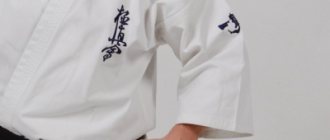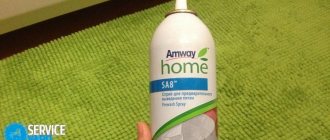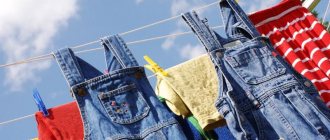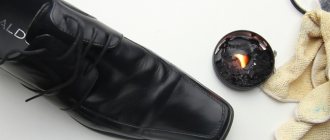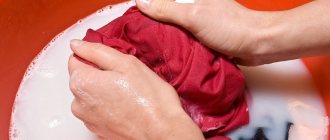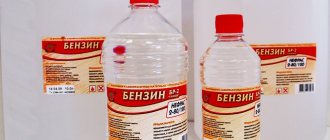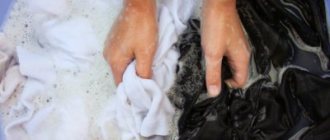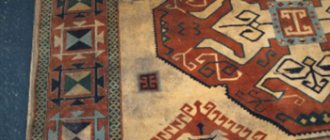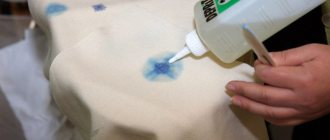Sports kimono are used for practicing oriental martial arts, the most common of which today are judo and karate. As a rule, such clothes are made from durable, lightweight cotton fabric that does not restrict movement and allows the body to breathe and move freely. Natural cotton absorbs moisture and prevents sweating. It is comfortable to wear and resistant to wear.
However, with frequent use and taking into account the specifics of use, the kimono begins to gradually lose its original appearance. To extend the life of an item and maintain its presentability, it is important to provide competent and timely care. In this article we will learn how to properly wash kimonos for karate, aikido, sambo, judo and other types of martial arts.
Basic care rules
For regular training, a black kimono is usually worn. White clothes are reserved for competitions and demonstrations. Washing black clothes does not cause any hassle. The only thing is that you need to wash such clothes separately from colored and white linen. Among other things, it is important to observe the temperature regime.
You'll have to tinker with a white kimono. Such clothes gradually lose their freshness and whiteness, becoming yellowed or gray. In such cases, you have to buy a new suit or bleach the old one. It is advisable to wash the kimono belt by hand. For colored belts, select appropriate powders.
After each workout, hand rinse the product in cold water. This will eliminate sweat, dust and dirt, and refresh the item. If your clothes have an unpleasant odor, add a little table vinegar or a few drops of potassium permanganate to the water. Due to regular rinsing, you will not have to wash your kimono often, which will save time and extend the life of your sportswear. It is not recommended to wash a kimono in a washing machine more than twice a month, otherwise the material will quickly wear out.
For washing, choose liquid gels, as powders are difficult and take a long time to wash out. And particles of the detergent composition that remain in the fabric can cause an allergic reaction in the future. Among other things, they negatively affect the structure of the material.
It is preferable to use the manual method, as it has a more gentle and gentle effect. Whenever washing, be sure to observe the temperature regime, as cotton does not tolerate hot water. In hot water, the fabric shrinks up to 10%. If the material does shrink, the advice in the article “How to stretch cotton” will help save the situation.
How to clean a belt?
An integral part of a martial arts fighter's costume is a belt. Depending on the level of skill, a belt of a certain color is selected.
You should not ignore belt care , since a dirty element of the costume against the backdrop of a snow-white kimono spoils the overall impression of the fighter’s appearance.
The easiest way to wash a white belt is. It is placed in a special net (or pillowcase) and loaded into the drum of the washing machine along with the kimono.
Colored belts are washed according to the following scheme:
Bleaching the kimono and belt at the same time. This will help avoid a situation where individual parts of one martial arts suit differ in shade.
Hand washing rules
- Before washing a kimono, look at the label and follow the recommendations;
- Before washing, turn the kimono inside out and only then put it in water;
- Soak the clothes for several hours in water with detergent at a temperature of 40-50 degrees;
- We wash black and colored items in warm water at a temperature of up to 40 degrees;
- After soaking, you need to wash and rinse the items several times until the detergent is completely washed off;
- When washing, pay special attention to the collar, cuffs and armpit area, as these areas get dirty more and faster than others;
- During the final rinse, add a little fabric or hair conditioner to the water to make the fabric soft and comfortable to the touch;
- Wring out the product carefully, without twisting, and hang to dry in a well-ventilated place, away from direct sunlight, batteries and electrical appliances;
- If there are difficult stains on your kimono, you can use non-chlorine stain removers. Such products contain components that penetrate deep into the fibers and clean the product in a few minutes;
- Laundry soap will also help remove stains. Due to its high acid content, it removes almost every stain. Lather the contaminated area, leave for half an hour and rinse, and finally wash using the usual method.
- Instead of laundry soap, you can use special Antipyatin soap. This is an inexpensive, accessible and safe product that easily removes various types of contaminants. It does not cause allergies and is great for washing baby clothes.
How to remove armpit sweat stains using household chemicals
There are a number of professional tools that guarantee a solution to the problem. The following products have been developed to combat sweat stains:
- Frau Schmidt. This wonderful Austrian remedy will help deal with stains of all kinds, including deodorant stains under the arms. Strong, but at the same time gentle towards things and hands.
- Vanish. One of the most popular stain removers. Sold in any store, the price is reasonable.
- Amway Pre Wash. A real assistant for the housewife. Deodorant stains are a simple task for him. The only negative is that it cannot be found on the open market; you need to specially order it from distributors.
- Beckmann. A stain remover spray that is designed specifically to combat this type of stain. Suitable for any type of fabric.
There are many ways to combat yellow stains from sweat on white things. It’s worth trying several options to find one that’s convenient and effective for you.
Source of the article: https://gidpotkanyam.ru/otstirat-zhyoltye-pyatna-na-podmyshkax.html
How to remove yellow stains from sweat from white clothes under the arms: ways and means of removing stains from light-colored clothes, How to wash a white kimono from yellow stains under the arms.
Machine washable
As we already said, you don’t need to wash your clothes in the washing machine too often, otherwise they will wear out quickly. To wash a kimono in an automatic washing machine, use a special bag for washing clothes. This will protect the fabric from the mechanical impact of the drum.
Before washing, we sort the laundry by color. It is advisable to wash cotton separately or only with natural fabrics, such as linen. For washing, select a delicate wash cycle at a temperature of 30-40 degrees. Clothing shrinks in hotter water.
Set the power to about 600 rpm and do not spin. Before washing, turn the kimono inside out, put it in a bag and put it in the drum.
After washing, we immediately take out the kimono and hang it on hangers or lay it out horizontally. You can also hang the product on a rope, since cotton is not prone to stretching. We also dry the kimono in a well-ventilated area, away from direct ultraviolet radiation, radiators and electrical appliances.
Do not dry items in the dryer! If necessary, the washed kimono can be ironed through gauze with an iron with low heat. And in order not to iron things, before drying, smooth the material with your hands, remove folds and creases.
Caring for your kimono belt
The belt is the face of the athlete, for this reason it is necessary to keep it extremely clean. You may have heard that some traditional martial arts schools consider it unacceptable to wash belts. But it looks very strange when the kimono is shining, but the belt has long been gray.
The light colored belt must be washed by hand. Bleach it with the rest of your clothes so there is no color difference.
For dark shades, powder for colored items is sufficient. Don't forget the tag. You need to choose a temperature and washing mode so that your clothes are not damaged.
How to bleach a kimono
If clothes lose their whiteness, begin to turn yellow or gray, you will have to use bleaching. You can use special bleaches or whiteness after washing the products by hand or in a machine. How to bleach white things, see more here.
Bleach and whiteners must not contain chlorine. This is an extremely aggressive component that negatively affects tissue structure and human health. It quickly thins and wears out even dense materials and causes an allergic reaction.
Laundry soap will whiten a grayed item. Lather the product and leave for two hours, and then wash by hand. The safest methods will be various folk remedies. They will preserve the properties and appearance of the fabrics and will not cause an allergic reaction.
Remove stains and eliminate odors
If a judo kimono is made of high-quality material, it retains its white tint for a long time. Inexpensive suits lose their appearance, become gray or yellow even if washing rules are followed.
When bleaching cotton fabric, special agents are used to increase the alkalinity of the washing powder. With the help of these products, fats are destroyed - the main cause of pollution, which contributes to the acquisition of an unsightly shade.
If a judo suit or karate kimono is bleached in accordance with the rules, the quality of the fabric will not change. You should select products that do not contain chlorine, since fiber destruction occurs precisely because of it.
It is known that kimono material quickly absorbs unpleasant odors. In order to return the product to its original freshness, it is recommended to immediately dry the kimono upon completion of the next workout. If there is a need to rinse the suit, you can add two tablespoons of vinegar to the water - this will certainly eliminate the smell.
Whitening without chemicals
Ash is a universal product that washes dishes and hair, is used as fertilizer for the garden, and is also suitable for washing and bleaching clothes. Use ash only of plant origin, preferably deciduous trees, such as birch or aspen.
To wash white clothes, take the ash and place it in gauze, tie it tightly and place it in a container with water and dirty clothes. Place on the stove and boil. Let the solution cool, then wash and rinse the items in clean water. Universal ash is suitable for bleaching natural cotton, linen and synthetics.
In addition, you can use a solution of potassium permanganate and a soap solution made from shavings of laundry or antibacterial soap. We combine both mixtures and put two or three white things there that need to be bleached. Leave it overnight and then rinse. As a result, you will get snow-white fabric without stains or dirt.
Chemical bleaching compounds will replace ammonia and hydrogen peroxide. For 10 liters of water add 2 tablespoons of peroxide and 1 tablespoon of ammonia. Mix and soak the items in the prepared solution. Leave for several hours and rinse. As a result, things will return freshness and whiteness. How else to return the whiteness to grayed things, read the link.
How to use improvised means
There are dozens of different ways to remove yellow spots under your arms. If the effect is not too pronounced, then you should rinse the item thoroughly and apply another product.
Hydrogen peroxide
An indispensable item for removing stains from sweat or antiperspirant. You can simply apply it to the stain, wait 30 minutes and rinse with water, then wash as usual. Peroxide is also ideal for those cases when an item that has been sitting for a long time acquires a yellowish tint. In this case, we follow the instructions:
- Dilute peroxide in water in a ratio of 1 tbsp. l. per glass.
- Soak for 30 minutes.
- Wash as usual.
Peroxide perfectly removes odor and yellowness from sweat. This is a gentle bleach for all types of light-colored fabrics.
Ammonia and aspirin
To give your T-shirt a fresh look and remove sweat and antiperspirant stains, just use the usual products:
- Dilute 1 tsp. ammonia in 100 ml of water.
- Apply the solution to the stain.
- Crush several aspirin tablets into powder and dilute in a small amount of water.
- Lightly wring out the shirt and apply a mixture of aspirin and water to the stain.
As a result, we get the effect of dry cleaning at home.
Laundry soap
The best way to remove sweat stains, especially if they are fresh. Suitable for light and dark things:
- Wet the cloth.
- Rub the stain with laundry soap.
- After 15 minutes, put it in the washing machine.
If contamination cannot be resolved, then the issue can be resolved by boiling. Pay attention to the label: not all things can withstand high temperatures.
Soda and table salt
Two products that are always on hand and cost pennies. They remove yellowness perfectly, but they have slight differences.
Salt:
- Sprinkle contaminated areas, lightly moistening them with water.
- Leave for 12 hours.
- Scrub with an old toothbrush.
Soda:
- Dissolve in water to form a thick paste.
- Apply to fabric and leave until completely dry.
- Clean with a brush.
After washing, not only the disappearance of stains is noted, but also a refreshment of color. The thing is like new again.
Acetic acid
It cannot be applied to white things, otherwise yellowed stains will remain after drying. It will be quite difficult to remove them. But vinegar very effectively corrodes the substances formed during the reaction of sweat and antiperspirant. After use, the smell of sweat goes away and a feeling of freshness remains. You can use it to remove old stains:
- Soak a cotton swab in 9% vinegar.
- Wipe the cloth with it and leave overnight.
- Wash as usual.
Lemon acid
They use both freshly squeezed juice and dry acid, which can be purchased in the seasoning department:
- Squeeze lemon juice or dilute 1/3 tsp. citric acid crystals in 4 tbsp. l. water.
- Apply to stain.
- Wash after 15 minutes.
This product deodorizes and refreshes, so it is widely used if unpleasant odors appear in the closet during storage. The next time you wash, squeeze out the lemon juice and add it to the drum.
Dishwashing liquid
To combat sweat stains, especially old ones, gels containing glycerin are used. It is thanks to this that the stains dissolve. Please note that only transparent products can be used for light-colored items:
- Apply a thick layer of gel to the stain.
- Leave for an hour.
- Wash the product as usual.
Petrol
The most radical way to solve the problem. You need to take only highly purified gasoline, otherwise it will be difficult to hide, wash off or remove the smell:
- Wipe the contaminated areas with a moistened swab.
- Wash in warm water.
- Place in the washing machine.
Effective ways on how and what to remove yellow stains from sweat under the arms from white clothes
Sweat stains can appear on clothes even in people who use antiperspirants. Unsightly marks tend to remain on the material in the form of yellow streaks after drying.
It is not always possible to deal with them with regular washing. To return the damaged item to freshness and remove stains, you need to use home recipes or use ready-made household chemicals.
We’ll talk more about how and what to remove yellow sweat stains from white clothes in the article.
Features of washing medical gowns
It is not always possible to clean and bleach your robe at home yourself. Take into account the nature of the item's contamination. If it has been exposed to blood or other biological material of an infected person, and contact with it poses a health risk, the form is treated in a special way on the territory of the institution or disposed of.
You can clean and bleach workwear yourself if the stains on it do not pose a threat. And the choice of method depends on the color and quality of the fabric from which the item is made. Mostly cotton or calico is used for production. It is possible to use fabric with synthetic threads; they are more practical to wear, but require appropriate care; bleaching such material will be more difficult.
If the uniform has colored elements, such as on the pockets or collar, the approach to this clothing is different. Otherwise, after bleaching or regular cleaning, the parts may fade and stain the white material.
In order to wash workwear yourself outside the hospital, consider a number of recommendations:
- Uniforms for junior and senior level health workers are washed when soiled. For nursing staff who come into contact with patients every day during treatment procedures, laundry is done every day.
- Clean the robe in a machine or manually separately from personal belongings.
- Before cleaning, soak clothing in cold water with the addition of disinfectants specified in SanPiN standards.
Before the main wash, remove stains from the surface; the fabric can be bleached only after this.
Top 3 household chemicals
To combat sweat stains on clothes, both special products and universal stain removers are useful. For each such drug, instructions are given, following which is a prerequisite for successful processing.
"HG" for removing traces of sweat and deodorant from things
This drug is developed by a company from the Netherlands. The bottle has a small volume of 0.25 liters and is equipped with a spray nozzle for ease of use. Can be used not only on white, but also on colored fabrics.
HG Sweat Stain Remover is designed to pre-treat clothes before the main wash. If the products are processed immediately, without waiting for traces of sweat to age, the effect will be greater. Silk and wool should not be used on clothing.
The disadvantages include:
- old stains cannot be removed the first time;
- specific unpleasant odor;
- high price (from 400 rubles per bottle);
- uneconomical consumption for old stains.
Vanish, stain remover and brightener “Crystal white”
A large list of Vanish TM products allows you to choose the optimal stain remover. An oxygen-containing concentrate with a volume of 0.45 liters costs from 160 rubles per bottle. The product is available in packaging of various sizes.
Advantages:
- does not contain chlorine;
- suitable for stubborn stains;
- suitable for any fabrics, including wool and silk;
- availability.
Minus: the product may not cope with old sweat stains the first time.
FINCLEAN.RU, professional stain remover
The product FINCLEAN.RU is produced in Russia. The 2 kg container has a convenient packaging with a carrying handle and a measuring cup. Can be used either separately or together with washing powder.
Advantages:
- efficiency;
- environmental friendliness;
- can be used for white and colored clothes;
- disinfects;
- oxygenating agent;
- deodorizes;
- does not irritate the skin and respiratory tract;
- restores color.
Cons: high cost - about 1,000 rubles for a 2 kg container.
Rules for drying and ironing
To prevent the form from stretching, it must be dried and ironed properly. It is unacceptable to wring out and dry a kimono in a machine, otherwise deformation cannot be avoided. It is better to squeeze the product with your hands gently without twisting too much. It is recommended to dry it in the open air - on a balcony or street; you cannot hang it on a radiator. Some people prefer to take their clothes out into the cold to remove odors. If you follow simple rules, you will be able to avoid damage to the fabric.
The fact is that ironing cotton is extremely difficult even at high temperatures. Products with a woven structure should not be ironed, they just need to be washed and dried properly to prevent wrinkles.
Note! Many people starch kimonos to give the fabric shape and elasticity, but it must be done correctly. In cases where a large amount of starch and a thick solution is used, the product becomes too hard. Washing starch out of fabric will be problematic.
Washing and bleaching a kimono at home is quite simple. To do this, use mild chlorine-free bleaches, powders or liquid products for white laundry. You need to dry the uniform in the fresh air to avoid bad odors. Ironing is usually not required if all steps have been completed correctly.
What is prohibited?
Removing stains quickly and 100% can be difficult if they are old, or in cases where they were tried to be removed incorrectly. Before using one of the methods, it is necessary to analyze the type of fabric.
Preparations with chlorine are prohibited. Their use is not justified even for plain, snow-white products.
Heat
Items with traces of sweat that have not been washed should not be ironed - under the influence of the high temperature from the soleplate of the iron, the stains will become permanent.
You should pay attention to the water heating temperature indicated in recipes; high temperatures are not always recommended.
Only cotton items can be treated with hot water, much less boiled.
Intense mechanical impact
You should also not rub the stained areas too hard. This can cause deterioration and damage to the material, as well as driving dirt deeper into the fibers.
How to wash without pilling
Taffeta is not very prone to pilling, but with insufficient care it cannot be avoided. With their appearance, things wear out faster and lose their appearance.
Scotch tape for pellets
What should you pay attention to to prevent them from forming?
- Do not use a water temperature, washing or rinsing cycle that exceeds that indicated on the clothing. If you choose the machine method, do not forget to put the product in a special bag. This will prevent unnecessary friction between the clothes and the walls of the drum.
- For synthetic fabrics, purchase special gels that will be gentle on the fabric and help preserve the texture and color of the synthetics. This reduces the risk of pilling.
- During grooming, pay attention to areas of frequent friction: under the arms, where the handle of a bag rubs.
Have pills already appeared on your dress or trousers? In such cases, washing cannot get rid of them. This can only be done mechanically. Can be applied:
- Shaver is a special device for eliminating pilling on clothes. They can operate on batteries, accumulator, or mains. The problem is removed with circular movements after pressing the button. Can be used for almost any type of material, you only need to adjust the blade.
- A shaving machine will help if there are pellets on a small surface. To obtain the desired result, use an already used machine. Stretching of the product during the procedure is not allowed. Use the razor only from bottom to top. The machine is not used for clothes with long pile.
- Scotch tape is the safest and most affordable way. It needs to be torn off sharply from the clothes so that grains of thread remain on it.
As an alternative, you can use a comb and scissors, sandpaper.
Bleach "Whiteness"
What funds are needed?
You can wash sneakers using different means, and their choice depends on the material from which the shoes are made. There are several options:
- For textile sneakers, a high-quality washing powder is suitable. But it must be completely dissolved in water, otherwise small solid particles will get stuck in the fibers of the fabric and damage it. To avoid this, replace the powder with a gel or liquid product.
- For washing, regular solid or liquid soap is suitable, which copes well with minor stains. And laundry soap will help remove even stubborn stains.
- You can effectively clean white or heavily soiled sneakers using a stain remover, but without chlorine or other aggressive components. Use Antipyatin or Vanish.
- Leather sneakers are not subject to regular washing, and dirt does not eat into such material, so to remove them you can use a soap solution, applying it to the surface with a sponge.
- Suede sneakers should also not be washed, as the material can deteriorate when exposed to water. If the shoes are very dirty, then prepare foam from water and soap or washing powder, apply it to a sponge and carefully treat the surface of the products to prevent it from getting too wet. You can also use specialized products for shoes made from these materials to clean suede and nubuck.
